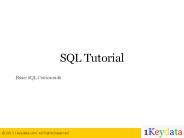PL/SQL - PowerPoint PPT Presentation
1 / 26
Title:
PL/SQL
Description:
PL/SQL Declaring Variables Note: The LONG datatype is similar to VARCHAR2, except that the maximum length of a LONG value is 32,760 bytes. Therefore, values longer ... – PowerPoint PPT presentation
Number of Views:81
Avg rating:3.0/5.0
Title: PL/SQL
1
PL/SQL
- Declaring Variables
2
PL/SQL Block Structure
- DECLARE (Optional)
- Variables, cursors, user-defined exceptions
- BEGIN (Mandatory)
- - SQL statements
- - PL/SQL statements
- EXCEPTION (Optional)
- Actions to perform when errors occur
- END (Mandatory)
3
Block Types
Anonymous
- DECLARE
- BEGIN
- --statements
- EXCEPTION
- END
4
Program Construct
- Tools Construct
- Anonymous blocks
- Application procedures or functions
- Application Packages
- Application triggers
- Object Types
- Database Server Construct
- Anonymous blocks
- Stored procedures or functions
- Stored packages
- Database triggers
- Object types
5
Use of Variables
- Temporary storage of data
- Manipulation of stored values
- Reusability
- Ease of maintenance
6
Handling Variables in PL/SQL
- Declare and initialize variables in the
declaration section - Assign new values to variables in the executable
section - Pass values into PL/SQL blocks through parameters
- View results through output variables
7
Types of Variables
- PL/SQL variables
- Scalar
- Composite
- Reference
- LOB (large objects)
- Non-PL/SQL variables
- Bind variables
- Host variables
8
Using iSQLPlus Variables
- PL/SQL does not have input or output capability
of its own - You can reference substitution variables within a
PL/SQL block with a preceding ampersand - iSQLPlus host (or bind) variables can be used
to pass run time values out of the PL/SQL block
back to the iSQLPlus environment
9
Declaring PL/SQL Variables
- Syntax
- Identifier CONSTANT datatype NOT NULL
DEFAULT expr - Example
Declare v_hiredate DATE
v_deptno NUMBER(2) NOT NULL 10
v_location VARCHAR2(13) 'Atlanta'
c_comm CONSTANT NUMBER 1400
10
Declaring PL/SQL Variables
- Guidelines
- Follow naming conventions.
- Initialize variables designated as NOT NULL.
- Initialize identifiers by using the assignment
operator () or the DEFAULT reserved word. - Declare at most one identifier per line.
11
Naming Rules
- Two variables can have the same name, provided
they are in different blocks. - The variable name (identifier) should not be the
same as the name of table columns used in the
block. - The names of the variables must not be longer
than 30 characters. The first character must be a
letter the remaining characters can be letters,
numbers, or special symbols
DECLARE empno NUMBER(4) BEGIN
SELECT empno INTO empno FROM emp WHERE
ename 'SMITH' END
Adopt a naming convention for PL/SQL
identifiers for example, v_empno
12
Assigning Values to Variables
Syntax Examples Set a predefined hiredate for
new employees.
- identifier expr
v_hiredate '31-DEC-98'
Set the employee name to Maduro.
v_ename 'Maduro'
13
Variable Initialization and Keywords
- Using
- Assignment operator ()
- DEFAULT keyword
- NOT NULL constraint
14
Scalar Datatypes
- Hold a single value
- Have no internal components
25-OCT-99
TRUE
Four score and seven years ago our fathers
brought forth upon this continent, a new
nation, conceived in LIBERTY, and dedicated to
the proposition that all men are created equal.
256120.08
Atlanta
15
Base Scalar Datatypes
- VARCHAR2 (maximum_length)
- NUMBER (precision, scale)
- DATE
- CHAR (maximum_length)
- LONG
- LONG RAW
- BOOLEAN
- BINARY_INTEGER
- PLS_INTEGER
16
Scalar Variable Declarations
- Examples
v_job VARCHAR2(9) v_count BINARY_INTEGER
0 v_total_sal NUMBER(9,2) 0 v_orderdate DAT
E SYSDATE 7 c_tax_rate CONSTANT
NUMBER(3,2) 8.25 v_valid BOOLEAN NOT NULL
TRUE
17
The TYPE Attribute
- Declare a variable according to
- A database column definition
- Another previously declared variable
- Prefix TYPE with
- The database table and column
- The previously declared variable name
- Syntax
- Identifier Table.column_nameTYPE
18
Declaring Variables with the TYPE Attribute
- Examples
... v_ename emp.enameTYPE
v_balance NUMBER(7,2) v_min_balance v_ba
lanceTYPE 10 ...
19
Declaring Boolean Variables
- Only the values TRUE, FALSE, and NULL can be
assigned to a Boolean variable - The variables are compared by the logical
operators AND, OR, and NOT. - The variables always yield TRUE, FALSE, or NULL.
- Arithmatic, character, and date expressions can
be used to return a Boolean value
20
Composite Data Types
- Have internal components that can be manipulated
individually - Composite data types are of TABLE, RECORD, NESTED
TABLE, and VARRAY types
21
LOB Datatype Variables
Recipe (CLOB)
Photo (BLOB)
Movie (BFILE)
NCLOB
22
Bind Variables
O/S Bind Variable
23
Referencing Non-PL/SQL Variables
- Store the annual salary into a SQLPlus host
variable. - Reference non-PL/SQL variables as host variables.
- Prefix the references with a colon ().
g_monthly_sal v_sal / 12
24
- Example
- VARIABLE g_salary NUMBER
- BEGIN
- SELECT salary INTO g_salary FROM emp
- WHERE emp_id 178
- END
- /
- PRINT g_salary
25
DBMS_OUTPUT.PUT_LINE
- An Oracle-supplied packaged procedure
- An alternative for displaying data from a PL/SQL
block - Must be enabled in iSQLPlus with SET
SERVEROUTPUT ON
26
Example
- SET SERVEROUTPUT ON
- DEFINE p_annual_sal 60000
- DECLARE
- v_sal NUMBER(9,2) p_annual_sal
- BEGIN
- v_sal v_sal/12
- DBMS_OUTPUT.PUT_LINE (The monthly salary is
TO_CHAR(v_sal)) - END
- /































